M
|
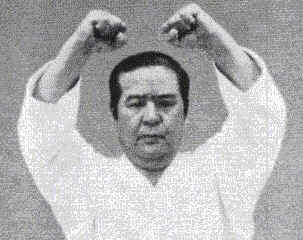
MANZO IWATA (1924 - 1993) was born in Tokyo, Japan , February 9, 1924. At the early age of 10, Manzo Iwata was first introduced to the Martial Art of Shito-ryu Karate by the manager of his families tea business (Iwata-en Tea Co.). While attending Jr. High School he also learned Judo and Kendo. A good friend of Manzo's grandfather, Ueshiba Morihei, the founder of AIKIDO, would teach Manzo when he would frequently stop by to visit. While enrolled at TO-YO University in Tokyo, in 1941, at the approximate age of 18, Manzo Iwata began training in Karate-do directly under the guidance of Grandmaster Kenwa Mabuni, the founder of Shito-ryu Karate-do.
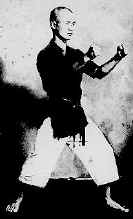
Manzo Iwata at University.
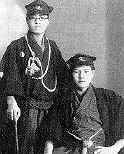
Manzo Iwata (seated).
In the next few years, very little information was ever documented regarding the specific type of training being conducted at the time, but what is known through reliable sources indicates Manzo Iwata became a very proficient and skillful fighter who developed tremendously strong and powerful arms. Besides being tough and possessing superior fighting ability, he also demonstrated a unique capacity for completely understanding the full essence of Grandmaster Mabuni's Shito-ryu system.
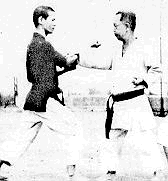
Manzo Iwata (L), Kenwa Mabuni (R).
Manzo Iwata received instruction in Kobudo Bojutsu (6ft. staff techniques) from Master Mabuni as well. It was during this time Master Mabuni felt Manzo Iwata would be suited more to the shorter staff-art of Jojutsu and encouraged him to seek instruction from Master Seiko Fujita, a longtime friend of Master Mabuni's from the early 1930's.
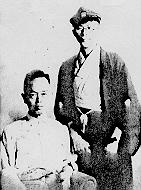
Master Mabuni (seated) and Master Fujita.
Master Fujita was considered by many to be a very mysterious martial artist. Master Mabuni was noted for being a very open-minded person that enjoyed the respect and close relationships with various masters of different martial arts. He was acutely aware of each systems short-comings, but always looked for the positive aspects in each art. Mabuni sensei included many of these positive aspects in the development and teaching of his Shito-ryu Karate especially in the GYAKU-WAZA (reverse techniques), and NAGE-WAZA (throwing techniques).
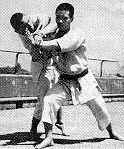
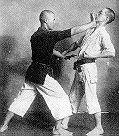
Manzo Iwata applying Gyaku-waza and Shotei-Uchi.
In 1943, Manzo Iwata was honoured by receiving the 'Shihan' (master/teacher) diploma of DAIENRYU JOJUTSU from Master Fujita, who later revealed to Manzo Iwata that he was actually the 14th generation Master of the KOGARYU NINJITSU system of martial arts.
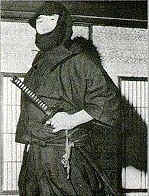
Master Seiko Fujita
After graduating from TO-YO University in 1944, Manzo Iwata received the 'Shihan' of Shito-ryu Karate-do directly from Master Kenwa Mabuni. A short time later, Master Mabuni requested Iwata Shihan to become 'Zenkuren-President' of Shito-Kai Karate-do Kanto District and establish a headquarters in the Tokyo area. He accepted the request and eventually established the headquarters at his home. Master Mabuni previously had moved to the Kansai District city of Osaka years before and established the western headquarters there.
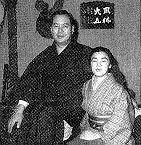
Mr. & Mrs. Iwata
Mrs. Manzo Iwata, affectionately referred to as 'OKUGATA', (a term indicating a very special martial art wife) had come to know Master Mabuni as a calm and quiet spoken gentleman who possessed a modest personality and never boasted about his Karate knowledge. He always conducted himself with dignity and respect worthy of the venerable masters that preceded him. He believed that Karate related matters should be discussed in the Dojo only, and not as a topic of general conversation. Mrs. Iwata recognized these similarities in the character of her husband Shihan Iwata. Shihan Iwata recalled that Master Mabuni had learned many Kata (fighting patterns) in the quest for the essence of Karate-do. He was the first to introduce 'Bunkai Kumite' and defined the meaning of each Kata for transmission to the next generation. Both Master Mabuni and Shihan Iwata were among the early pioneers that experimented with protective equipment for sparring practice (Bogu Kumite), but found them to be too restrictive and cumbersome, and eventually discarded the idea.


Manzo Iwata sensei performing Bassai-Dai.
 .
.
Manzo Iwata Shihan felt it wasn't necessary for anyone to watch him personally train because he believed this training was for self-development and not an open demonstration of his considerable abilities. He learned long ago from Master Mabuni the fundamental basics of Shito-ryu Karate lie in the simple, practical and logical approach to self-defense. This he pointed out was clearly demonstrated in the explanation of techniques that incorporate the proper concentration of power (both strong and weak) combined with the correct attitude. During the next few years Iwata Shihan also continued his training as 'UCHI-DESHI' (principal disciple) with Master Fujita, and in 1948, was personally directed to accept all the hereditary knowledge and assume the leadership of NANBAN SATORYU KENPO, (a Jujutsu-like grappling combat system) including, SHINGETSU-RYU SHURIKEN JUTSU (throwing-projectile art).
He received his Shihan diploma from Master Fujita and accepted the position of 'SOKE'.
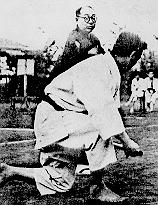
Master Fujita (glasses) and Master Iwata.
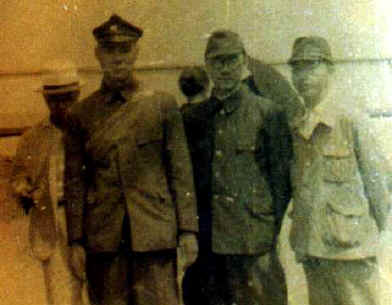
(L-R) Rare photo of Master Iwata, Master Fujita and Grandmaster Mabuni Kenwa.
The term 'Soke' is a peculiar form of Japanese culture which refers to a position of honor or title of honor conferred on the first born son, or a specially selected person to accept all the hereditary knowledge and traditions associated with that particular system which was handed down continually from one generation to the next.
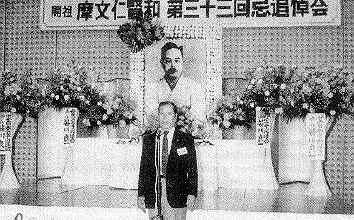
After the unexpected death of Grandmaster Kenwa Mabuni on May 23, 1952, Kenei Mabuni (the first born son) was appointed as the second 'Soke' of Shito-ryu Karate-do and maintained the Kansai headquarters in Osaka, while Master Manzo Iwata was Kanto District President of the Nihon Karate-do Kai Shito-ryu system in November of 1960.
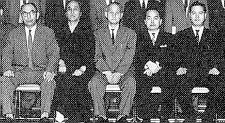
(L-R): Kinjo Sensei, Yamaguchi Sensei,
Ohtsuka Sensei, Mabuni Kenei Sensei,
and Manzo Iwata Sensei.
Special events and competitions were held separately the next few years by both headquarters until April 1964, when the first joint All-Japan Shito-ryu Karate-do Championships was held.
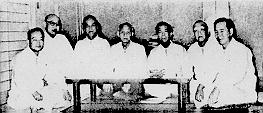
Rare photo of a meeting of Masters.
(L-R): Nakayama Sensei, Eriguchi Sensei, Yamaguchi Sensei,
Ohtsuka Sensei, Takagi Sensei, Sakagami Sensei & Iwata Sensei.
In October 1964, the formation of the FEDERATION OF ALL-JAPAN KARATE-DO ORGANIZATIONS (F.A.J.K.O.) was also due in large part to the tremendous efforts of Master Iwata, who became the youngest Shihan of any Karate-do system to be elevated to the level of 8th Dan by F.A.J.K.O.
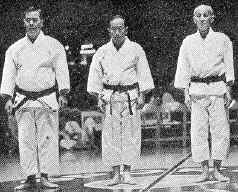
Iwata
Manzo, Nakyama Masatoshi, Ohtsuka Hironori
at Los Angles' Sports Arena, October 19, 1968
In 1972, Manzo Iwata was involved in a motor vehicle accident and was in a coma for approximately 2 months. His strong will and superior Karate ability is credited with bringing him out of the coma.
Over the years a definite need arose to merge the two existing headquarters of Shito-ryu's Nihon Karate-do Kai into one, and on February 1973, the joint body was inaugurated as the JAPAN KARATE-DO FEDERATION-SHITO-KAI.
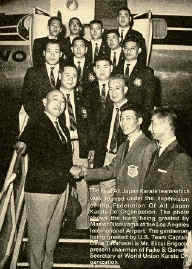
Front row (L-R): Eiichi
Eriguchi, Gene Takahashi, Hidetaka Nishiyama.
Manzo Iwata sensei standing directly behind Eriguchi sensei.
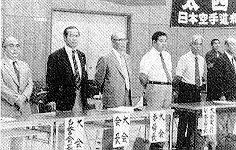
(L) Kenei
Mabuni, Manzo Iwata, Sakio Ken, Tokio Hisatomi (far right).
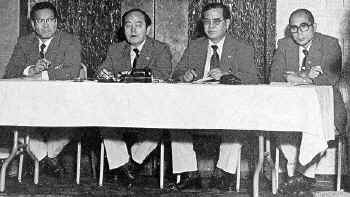
1975 WUKO 3rd World Karate-do Championships, Long Beach, California.
(L-R): Teru Hayashi, Kenei Mabuni, Manzo Iwata, Hiroshi Kinjo.
Master Iwata continued to promote Shito-ryu Karate-do around the world and never varied from the teachings and philosophy of Grandmaster Mabuni, especially, in the area of the transmission of Kata and related Bunkai.
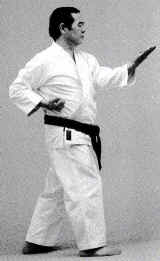
Iwata sensei performing Gojushiho
Iwata Shihan recalled that Grandmaster Kenwa Mabuni was very rigorous in transmitting the techniques and Kata forms to him. "Master Mabuni tried to teach us until we grasped the meaning of each technique and Kata. He was very thorough in teaching us the respective features and differences between the Itosu and Higaonna schools. He did not alter or deform what he had learned, and was very particular about the correct transmission of the original techniques and Kata. "Master Iwata personally believed that, " the student who is willing to learn, will be the one who learns the best." He expected the students to show initiative and to ask questions, then he would be more than willing to teach them as much as he could digest.

(L) Genzo Iwata, Tetsu Sato, Manzo Iwata (R) at Moscow University, 1980
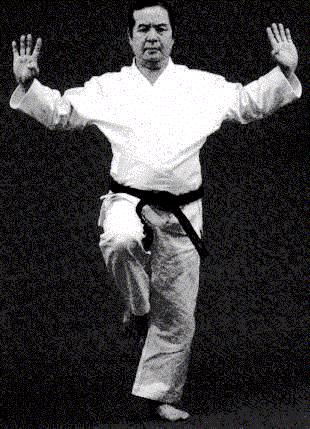
Iwata Sensei performing Sochin
He stressed that Shito-ryu Karate-do was a system that was composed of logical and practical techniques which utilized a minimum of wasted movement to produce the maximum effect without unnecessary wasted energy. This, he firmly believed could be easily accomplished by constantly striving to achieve the proper Kamae and correct positions of techniques and Kata form. Master Iwata continued the further development of Shito-ryu Karate-do through many of his students which included Genzo Iwata, his son, (Chief instructor - Iwata Honbu Dojo) and Shihan Kunio Murayama (Chief Technical Director - Mexico), just to mention a few. On March 20-21, 1993, the inaugural formation of the WORLD SHITO-RYU KARATE-DO FEDERATION and the 1st. World Shito-ryu Karate-do Championships were held at the Tokyo Budokan, in Ayase, Japan.
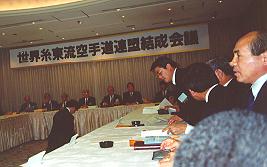
March 20, 1993, Genzo Iwata Sensei addressing the
First World Shito-Ryu Congress in Osaka
with Murayama Sensei listening attentively (foreground).
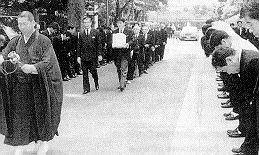
Master Manzo Iwata passed away on Friday, June 4, 1993.
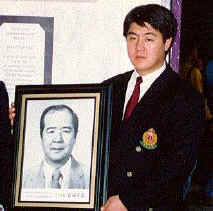
Master Iwata (photo), Genzo Iwata Sensei
The legacy he left behind for his son, Genzo, is 'SHOSHIN SHOGAI', which literally translates as 'SHO'-(First), 'SHIN'-(Mind or Heart), 'SHO'-(Life), and 'GAI'-(Continue). This can be expressed as meaning, 'to learn Karate, first show your mind and heart to be honest and pure, clean and gentle and be courteous all through life while maintaining a passion to continue to learn more and more, since the art of Karate-do is unlimited.
References/Bibliography
Samurai Magazine. Official Publication of All-American Karate Federation. Brooklyn, New York: Complete Sports Publication , Inc., 1974.
Black Belt Magazine, World's leading Magazine of Self Defence: Black Belt, Inc., Feb., 1969.
Karate Illustrated Magazine. Burbank California: Rainbow Productions, Feb., 1976.
Dubinin Valeriy. Russian Shito-ryu Karate-do Federation, Quarterly News Journal: 1996.
Elias Calderoni Jose Luis. Karate-do Shito-ryu, Shito-kai Mexico: Monterrey, Mexico,1986.
Elias Calderoni Jose Luis. Personal Data & Photograph Archives: Monterrey, Mexico.
Tokaido Karategi Company. Martial Arts Supply Catalogue: Tokyo, Japan, 1994.
Iwata Manzo. Shito-ryu Karate, Karatedo: Seibido Sports Series, 1989.
Moledzki Sam. Personal Data & Photograph Archives.
Karatedo Magazine-Japan, 1978.